The Tulane University School of Medicine was founded in 1834 as the Medical College of Louisiana. The school began with seven professors teaching the disciplines of anatomy and physiology, chemistry, material medica, principles and practice of medicine, surgery, obstetrics, and diseases of women and children. Ophthalmology was not taught as a distinct specialty until 1867.
The Department of Ophthalmology has an illustrious history. Some of the greatest physicians in the field of ophthalmology have played important roles in building the department. We invite you to enjoy a brief look at some of the people and the events of the past that shaped the Department of Ophthalmology.
Lecturers (1867-1907) more
Specialties began to emerge in American medicine by the 1850s. The American Ophthalmological Society (AOS) was founded in 1864. To teach the new specialties, Tulane established a special faculty position of “Lecturer.” The first Lecturer was an ophthalmologist, Dr. Bolling A. Pope, who served from 1867-68, making ophthalmology the first specialty to be taught at Tulane. In 1879, Dr. Pope became the first vice-president of the new Section on Ophthalmology of the American Medical Association, and later, he became the Chairman in 1880.
The Lecturers in Ophthalmology were as follows:
1867-1868: Dr. Bolling A. Pope
1869-1873: none
1873-1877: Dr. Victor Grima
1877-1884: Dr. Edward Harrison
1884-1890: Dr. Stirling D. Kennedy
1890-1892: Dr. William Cook Ayers
1892-1907: Dr. Edward Wynn Jones
In 1907, the School of Medicine Faculty was reorganized, prompting the resignation of Dr. Jones and the end of the Lecturer era. Private practitioners began giving their time to teach new physicians, launching a long tradition of pro bono service that would come to define the Tulane Ophthalmology Department.
Residency Training Begins more
 During Tulane’s Lecturer phase, physicians pushed for additional instruction following graduation. In 1858, a group of practitioners formed the New Orleans Polyclinic, which became the third medical post-graduate school in the United States. By 1906 the Polyclinic had become the Post-graduate Medical Department of the College of Medicine of Tulane University, marking the beginning of formal residency training at Tulane Medical School.
During Tulane’s Lecturer phase, physicians pushed for additional instruction following graduation. In 1858, a group of practitioners formed the New Orleans Polyclinic, which became the third medical post-graduate school in the United States. By 1906 the Polyclinic had become the Post-graduate Medical Department of the College of Medicine of Tulane University, marking the beginning of formal residency training at Tulane Medical School.
Dr. Henry Dickson Bruns (1859-1933), the first professor of ophthalmology was one of the city’s leading ophthalmologists. (Photo circa 1915).
Dr. Marcus Feingold (1907-25)
The Beginning of the Eye Department more
The faculty of the Medical School was reorganized in 1907, and the teaching of ophthalmology was assigned to a “Department of Ophthalmology.” The first professor of this new department was Dr. Marcus Feingold (1871-1925).
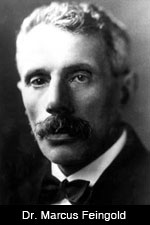 Dr. Feingold, a Rumanian immigrant, served as chairman for 18 years, until his death on December 26, 1925, at the age of 54. He also was chief of ophthalmology at Touro Hospital, a well-known facility. He contributed much to the ocular care of patients, both rich and poor. He was among the first to describe angioid streaks in association with age-related macular degeneration. Dr. Feingold was only 36 when he became chairman in 1907. He gradually enlarged the Eye Department so that by 1923, it contained the following faculty members:
Dr. Feingold, a Rumanian immigrant, served as chairman for 18 years, until his death on December 26, 1925, at the age of 54. He also was chief of ophthalmology at Touro Hospital, a well-known facility. He contributed much to the ocular care of patients, both rich and poor. He was among the first to describe angioid streaks in association with age-related macular degeneration. Dr. Feingold was only 36 when he became chairman in 1907. He gradually enlarged the Eye Department so that by 1923, it contained the following faculty members:
Marcus Feingold, MD, FACS - Professor
Charles Adolph Bahn, MD - Assistant Professor
Henry Nathan Blum, MD, FACS - Assistant Professor
Melvin F. Meyer, MD - Assistant
A.G. Thomas, MD - Assistant
Jonas William Rosenthal, MD - Assistant
Dr. Jonas William Rosenthal was the father of Dr. J. William Rosenthal, who was the curator of the Museum of the American Academy of Ophthalmology.
Dr. Matas’ Eye more
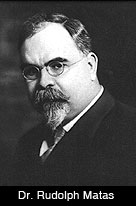 Dr. Rudolph Matas remains, even today, one of Tulane’s most famous faculty members. He was considered one of the leading cardiovascular surgeons in the United States. His introduction of the suture for the cure of aneurysm won him international fame and caused Sir William Osler to hail him as the “Father of Vascular Surgery.” Unfortunately, Dr. Matas accidentally inoculated his own eye with material from a gonococcal tuboovarian abscess. Dr. Marcus Feingold undertook the care of Dr. Matas, and, over the next three months, deferred his private practice and lived in the Matas home.
Dr. Rudolph Matas remains, even today, one of Tulane’s most famous faculty members. He was considered one of the leading cardiovascular surgeons in the United States. His introduction of the suture for the cure of aneurysm won him international fame and caused Sir William Osler to hail him as the “Father of Vascular Surgery.” Unfortunately, Dr. Matas accidentally inoculated his own eye with material from a gonococcal tuboovarian abscess. Dr. Marcus Feingold undertook the care of Dr. Matas, and, over the next three months, deferred his private practice and lived in the Matas home.
Night and day, Dr. Feingold and the attendant nurses irrigated Dr. Matas’ eye and instilled argyrol. Eventually, a corneal ulcer developed and perforated. Dr. Feingold had to enucleate Dr. Matas’ eye.
Dr. Wiley Ross Buffington (1926-1940) more
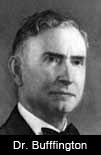 In June of 1926, Dr. Wiley Ross Buffington (1875-1950) succeeded Dr. Feingold as chairman of the Eye Department. Dr. Buffington had been a general practitioner until 1919 and when at the age of 44. He began specialty training at the Eye, Ear, Nose, and Throat Hospital in New Orleans. In 1921, at age 46, he began the practice of ophthalmology as the junior associate of Dr. H. Dickson Bruns, who was professor of diseases of the eye at the Polyclinic. Dr. Buffington served as chairman from age 51 until he retired in 1940, at the age of 65.
In June of 1926, Dr. Wiley Ross Buffington (1875-1950) succeeded Dr. Feingold as chairman of the Eye Department. Dr. Buffington had been a general practitioner until 1919 and when at the age of 44. He began specialty training at the Eye, Ear, Nose, and Throat Hospital in New Orleans. In 1921, at age 46, he began the practice of ophthalmology as the junior associate of Dr. H. Dickson Bruns, who was professor of diseases of the eye at the Polyclinic. Dr. Buffington served as chairman from age 51 until he retired in 1940, at the age of 65.
Dr. William Burton Clark (1940-1953) more
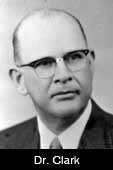 In June of 1940, at age 38, Dr. William Burton Clark (1902-1975) succeeded Dr. Buffington as chairman of the Eye Department, serving in that capacity for 13 years. He was the last of the private practitioners to serve as chair on a voluntary basis, as he received no compensation from the University. In the late 1940s Dr. Clark realized that he was unable to devote sufficient time to the chairmanship, and he began searching for a successor. In 1949 he obtained a $50,000 grant from the Schleider Foundation of New Orleans for the development of the Eye Department under his eventual successor, Dr. James Allen.
In June of 1940, at age 38, Dr. William Burton Clark (1902-1975) succeeded Dr. Buffington as chairman of the Eye Department, serving in that capacity for 13 years. He was the last of the private practitioners to serve as chair on a voluntary basis, as he received no compensation from the University. In the late 1940s Dr. Clark realized that he was unable to devote sufficient time to the chairmanship, and he began searching for a successor. In 1949 he obtained a $50,000 grant from the Schleider Foundation of New Orleans for the development of the Eye Department under his eventual successor, Dr. James Allen.
This was a major turning point in the development of the Tulane Eye Department. Previously, all of the chairmen were part-time, unsalaried, private practitioners who gave generously of their time as a professional obligation. So too did the other members of the faculty, most of whom had an allotted time of service at Charity Hospital; Touro Infirmary; or the Eye, Ear, Nose, and Throat Hospital’s indigent clinic. It was considered an honor and an obligation to donate time and professional skill to the care of indigent patients and to teaching residents.
However, all this changed after World War II. There was an explosion of scientific knowledge, and medical schools sought full-time academicians to develop their residency programs.
Dr. Clark was one of the founders of the Southern Eye Bank of New Orleans and also helped to found the New Orleans Academy of Ophthalmology.
Dr. James Harrill Allen (1953-1971) more
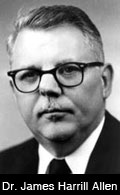 Dr. James Harrill Allen (1906-1992) was recruited by Dr. Clark as the first full-time academician to head the Tulane Ophthalmology Department, becoming Chairman in 1953. He remained Chairman for 18 years, until 1971. He definitely was a full-time teacher, as he had Grand Rounds with residents on Sunday mornings, at which time he would personally examine all indigent eye patients admitted to Charity Hospital. He expected residents to know the medical condition of their patients and how a systemic disease might relate to eye disease.
Dr. James Harrill Allen (1906-1992) was recruited by Dr. Clark as the first full-time academician to head the Tulane Ophthalmology Department, becoming Chairman in 1953. He remained Chairman for 18 years, until 1971. He definitely was a full-time teacher, as he had Grand Rounds with residents on Sunday mornings, at which time he would personally examine all indigent eye patients admitted to Charity Hospital. He expected residents to know the medical condition of their patients and how a systemic disease might relate to eye disease.
The year prior to coming to Tulane, Dr. Allen had introduced a new form of medical meeting at the University of Iowa. He put on an intensive four-day review of a single subject, in this case strabismus. After coming to New Orleans, Dr. Allen organized in 1951 a similar such meeting in New Orleans, a four-day review of Medical Treatment and Ophthalmology. This meeting was to become the New Orleans Academy of Ophthalmology. Incidentally, the meeting back in Iowa was the beginning of the American Association for Pediatric Ophthalmology and Strabismus (AAPOS).
Leprosy more
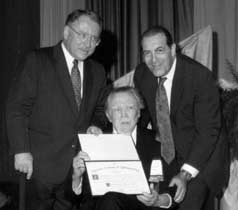 The US Public Health Service Hospital in Carville, Louisiana, was the only hospital for Hansen’s Disease in the continental United States. Soon after coming to Tulane, Dr. Allen established the first eye department at the hospital and began dispensing free care to patients on a weekly basis for over 25 years. Prior to his intervention, eye care was rendered by general practitioners. Although many of the patients had red eyes from keratitis or iridocyclitis, the general practitioners assumed they had glaucoma and prescribed pilocarpine. This drug actually aggravated the iritis. Dr. Allen introduced topical cycloplegics and steroids, maintaining vision for many of the patients.
The US Public Health Service Hospital in Carville, Louisiana, was the only hospital for Hansen’s Disease in the continental United States. Soon after coming to Tulane, Dr. Allen established the first eye department at the hospital and began dispensing free care to patients on a weekly basis for over 25 years. Prior to his intervention, eye care was rendered by general practitioners. Although many of the patients had red eyes from keratitis or iridocyclitis, the general practitioners assumed they had glaucoma and prescribed pilocarpine. This drug actually aggravated the iritis. Dr. Allen introduced topical cycloplegics and steroids, maintaining vision for many of the patients.
Because of his selfless service to these patients, Dr. Allen was awarded the first Outstanding Humanitarian Award by the American Academy of Ophthalmology in 1992.
Pictured above: Dr. Allen (seated) with Dr. Bruce Spivey (left), Executive Secretary of the American Academy of Ophthalmology, and Dr. Oliver Dabezies, Past President of the Tulane Eye Alumni Association.
Physicians Education Network (PEN) more
Dr. Allen was retired for four years, when House Bill 107 was passed by the Louisiana Legislature, allowing optometrists to use diagnostic drugs. Dr. Allen underwent a metamorphosis, coming out of a more-or-less sedentary retirement to become one of the most strident advocates of preserving medical aspects of ocular care for ophthalmology. He took this position long before any of the major ophthalmologic organizations became involved.
He organized the Ophthalmic Physicians’ Educational Network (OPEN), which became known as the Physicians’ Education Network, or PEN. A publication was launched that reported various attempts by limited licensed practitioners to expand their scope of practice. Cases of mismanagement in optometry were documented. Dr. Allen warned that optometrists would next seek legislation to use therapeutic drugs. In time, most of his early warnings became fact.
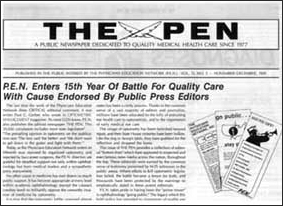
Image: Front page of the PEN - November/December 1991
Dr. Monte Gene Holland (1971-1976) more
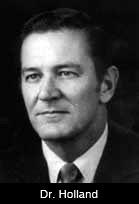 Dr. Monte Gene Holland (b. 1928) joined Tulane as an instructor in ophthalmology in 1957. He rose to full professor by 1966, at the age of 38. He was quite active in the basic research of glaucoma, particularly studies involving the innervation of the ciliary body and how this influenced aqueous outflow. His work helped usher in the age of the beta-blocking agents.
Dr. Monte Gene Holland (b. 1928) joined Tulane as an instructor in ophthalmology in 1957. He rose to full professor by 1966, at the age of 38. He was quite active in the basic research of glaucoma, particularly studies involving the innervation of the ciliary body and how this influenced aqueous outflow. His work helped usher in the age of the beta-blocking agents.
In mid-1971, Dr. Holland succeeded Dr. Allen as chairman at the age of 43. During his tenure of four and a half years as chairman, part-time, non-salaried faculty began to decline volunteering their time, viewing the full-time faculty as their competitors. Dr. Holland resigned at the end of 1976.
First Timolol Paper more
Dr. Holland’s influence in glaucoma research enabled a Tulane resident to publish a single paper. Dr. William A. Hubbard was able to perform a research project in conjunction with the Merck Sharp & Dohme company, testing a novel glaucoma agent. The drug was timolol, and Dr. Hubbard published the very first article in the world literature on human IOP reduction by timolol. This article appeared in Investigative Ophthalmology, 15(6): 489-92, 1976. Timolol became the most important advancement in medical glaucoma treatment in decades.

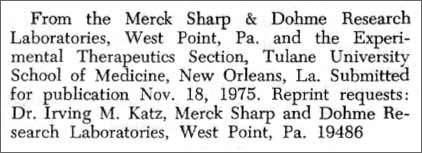
Interim Chairs more
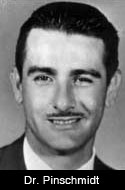 After Dr. Holland stepped down as chairman, Dr. Norman W. Pinschmidt (b. 1915) became the acting chairman at the age of 62. He was chairman for only three months, when he had a heart attack, followed by a stroke and was forced to retire.
After Dr. Holland stepped down as chairman, Dr. Norman W. Pinschmidt (b. 1915) became the acting chairman at the age of 62. He was chairman for only three months, when he had a heart attack, followed by a stroke and was forced to retire.
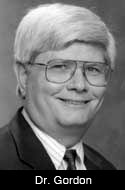 Dr. Robert Allen Gordon (b. 1944) took over as acting chairman, holding the position for 15 months. He had completed a pediatric fellowship only eight months before and was 32 years of age when tapped to lead the department. His lasting contribution to the department was remembering an ophthalmologist from his Baylor days named Dr. Delmar Caldwell, whom he recommended to the search committee. Dr. Caldwell was chosen as chairman in 1978. Dr. Gordon remains on the faculty as a pediatric ophthalmologist.
Dr. Robert Allen Gordon (b. 1944) took over as acting chairman, holding the position for 15 months. He had completed a pediatric fellowship only eight months before and was 32 years of age when tapped to lead the department. His lasting contribution to the department was remembering an ophthalmologist from his Baylor days named Dr. Delmar Caldwell, whom he recommended to the search committee. Dr. Caldwell was chosen as chairman in 1978. Dr. Gordon remains on the faculty as a pediatric ophthalmologist.
Dr. Delmar Caldwell (1976-present) more
 In 1978, Dr. Delmar Ray Caldwell (b. 1935) became professor and chairman of the department. There were vacant residency slots, a shortage of full-time faculty, financial problems within the department, and the school was just getting the Faculty Practice Plan started. Nevertheless, Dr. Caldwell invigorated the department, hiring a full complement of faculty, and making Ophthalmology the most productive department at Tulane. About 90 fellows and 125 residents have completed their training under his chairmanship.
In 1978, Dr. Delmar Ray Caldwell (b. 1935) became professor and chairman of the department. There were vacant residency slots, a shortage of full-time faculty, financial problems within the department, and the school was just getting the Faculty Practice Plan started. Nevertheless, Dr. Caldwell invigorated the department, hiring a full complement of faculty, and making Ophthalmology the most productive department at Tulane. About 90 fellows and 125 residents have completed their training under his chairmanship.
